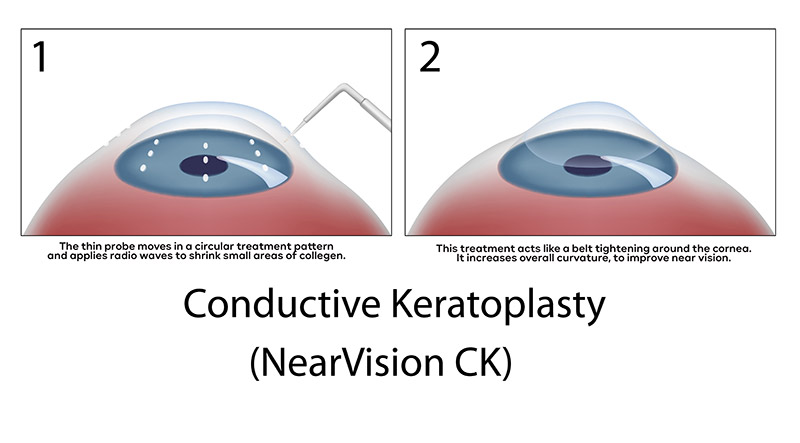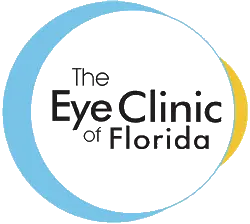Conductive Keratoplasty
Conductive Keratoplasty (CK) is a non-laser way to treat farsightedness and presbyopia. It strengthens the power of the cornea without laser and without treating the line of sight. It has been available since 2003. It’s lost popularity but still has utility when LASIK or PRK may not be the best choice. Currently, it’s main use is as a way to correct low amounts of farsightedness that might remain after cataract surgery. It has the benefit of not causing dry eye like LASIK can and a faster recovery than PRK. If you are 45 or older, had good vision all your life and hate your reading glasses CK could be right for you. Or, if you have mild Hyperopia (+.50 to +2.00) CK could improve both your distance and near vision. The procedure is quick, done in office, and has a fast recovery. The Eye Clinic of Florida does free CK screenings so call 813.538.1500 to schedule yours.
The procedure is quick, done in office, and has a fast recovery. The Eye Clinic of Florida does free CK screenings so call 813.538.1500 to schedule yours. No. And no honest doctor can absolutely guarantee a certain result from any vision treatment procedure. However, in the FDA clinical study, nearly 87% of patients had 20/20 vision while looking at objects in the distance and were able to read phonebook-size print (J3) after having NearVision CK (12-month follow-up data).
You’re likely a good candidate for NearVision CK if you:
- Are over age 40
- Had great vision your whole life
- Require reading glasses to compensate for fading near vision
- Or have had cataract surgery and are left with a prescription you would like to change
This is not a complete list of indications and contraindications
NearVision CK is typically performed on just one eye. However, if a patient’s prescription requires treatment in both eyes, CK can be performed on both eyes on the same day – one eye immediately after the other. Most patients are comfortable having the CK procedure performed on both eyes on the same day because the procedure is minimally invasive, takes less than three minutes, and is done in-office with only topical anesthesia.
As with any vision treatment procedure where the cornea is altered, certain precautions should be taken. After the NearVision CK procedure, patients should avoid getting contaminated water in their eyes for at least one week. This includes water from swimming pools, spas, lakes, and the ocean. When showering or taking baths, patients should keep their eyes closed in order to avoid getting soap and dirty water into their eyes. When exercising, sweat should be kept out of the eyes for at least a week after the procedure. Also, patients should avoid rubbing their eyes vigorously for two weeks following the procedure. Females should also avoid applying eye makeup for one week after the procedure.
No. NearVision CK was designed for those who struggle to read menus, price tags, or see their computer — symptoms of fading near vision require a steepening of the cornea.
With NearVision CK, the majority of patients can return to work and other normal activities the day after their procedure. Although recovery is fairly quick, it is advisable to be careful with your eyes and to avoid any strain. Those whose jobs demand intense clarity of vision (such as dentistry, surgery, or computer work) may want to give their eyes some extra rest for several days following the procedure before going back to work.
Both presbyopia and hyperopia are progressive diseases, which means that as people age, their eyes will continue to change – with or without surgical treatment. That being said, I have seen patients with results lasting 5 years or more.
The procedure has exhibited very minimal risk and almost no side effects. During the first 24 to 48 hours after NearVision CK, you may experience tearing and some discomfort, including a foreign-object sensation in the eyes. You may also experience an initial slight over-correction of your vision, which stabilizes during the following weeks.
The NearVision CK procedure is considered painless. You will be aware of support (speculum), which helps to hold your eye open. The most common sensation that patients experience is a feeling of pressure on the eye. After the procedure, there may be some mild discomfort, and many patients experience a foreign-object sensation or “scratchiness” in the eye. This usually subsides within 24 hours of the procedure.
The vast majority of patients do not need corrective lenses for most tasks after the NearVision CK procedure. However, depending on your age and the type of refractive disorder you have, you may need additional vision treatment at some point (surgery, reading glasses, or bifocals). This is because your eyes continue to change as you age.
Most patients will experience mild fluctuation in their vision after the procedure, but few notice it. Any fluctuation will usually subside within a few weeks. Patients who have a procedure to steepen the cornea (presbyopia or hyperopia), regardless of the procedure, usually require a longer stabilization period than those who receive a treatment that flattens the cornea (myopia).
Patients usually notice an immediate improvement in their vision after the NearVision CK procedure. However, it usually takes several weeks for the eyes to adjust to the final level of treatment.
Happy Patient Testimonials
Happy Patients Talk About Their Experience with Cataract Surgery and Dr. Mahootchi.







